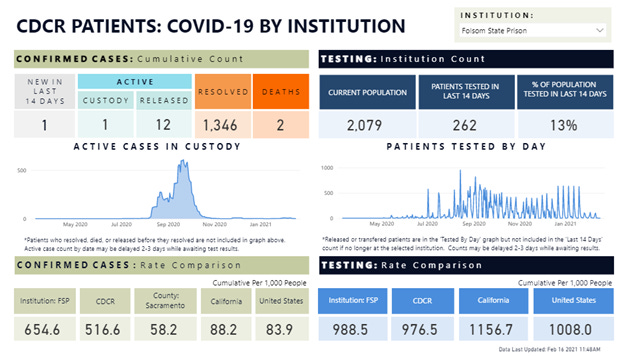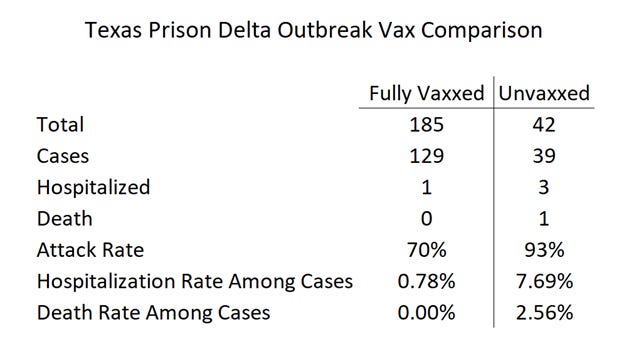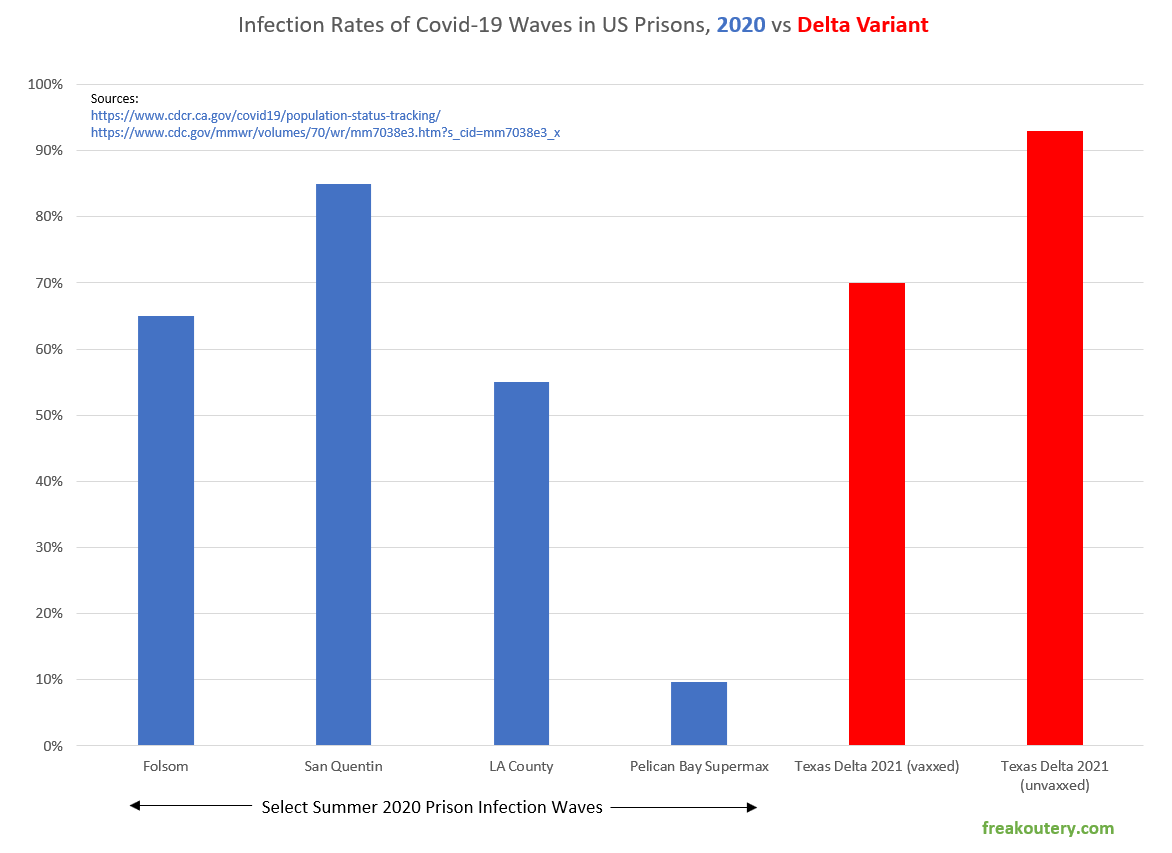Data From the Texas Prison Delta Outbreak Fits the Vax Narrative
Revisiting “human rats in human cages,” for science!
HWFO is, at it’s core, a heterodox publication that heavily questions dominant media narratives about hot button culture war topics, and does so with mathematics and systems analysis. For instance, we were able in February of 2021 to more accurately predict the herd immunity threshold (HIT) for Covid-19 than Fauci did, and used that prediction to accurately predict within about a two week window when the United States would achieve HIT from pre-Delta Covid-19. We did so by looking at the only truly controlled experiment we have on Covid-19 infection waves in humans. The United States prison system.
A study by the CDC and the Federal Bureau of Prisons recently went back to this well, and the results of that study support the dominant narrative that “the vaccine won’t stop Delta, but it will make it milder.” And it’s important for heterodox anti-establishment thinkers to be honest when the establishment may have gotten something right. Let’s proceed.
February Flashback
On February 16th of this year, HWFO pointed out that the best possible way to study Covid infections would be in a controlled Covid-19 infected human rat maze with universal testing, and that would be horribly unethical, terribly illegal, and we were already doing that.
The best possible way to determine herd immunity threshold (HIT) would be to trap a large captive human population in a giant rat maze, let them all get infected, and count the infection rates and the deaths. Skip all this mathematical modeling, Rt projection, computer simulation, and such, and just run the experiment. We obviously can’t do that because it would be illegal and unethical and wrong and whoever even thinks about mentioning such a horrid experiment should be cancelled and fired and run out of town by angry mobs with pitchforks and brooms, so we’ll never see any data from such an experiment.
Just kidding, we already did it, and we already know the answer.
The California Department of Corrections and Rehabilitation does an admirable job of keeping their Covid-19 data up to date, current, meticulous, and freely searchable from their website. Anyone can go there and look at infection waves in each of their prisons. You can go there and search for infection waves that look, graphically, like Wuhan’s, and see the numbers. Here’s Folsom State Prison:
Folsom State Prison achieved HIT, the infection rate at which Covid-19 goes away, at a 65% infection rate. (654.6 out of 1000) San Quentin achieved HIT at 84% infection rate. LA County achieved it at 55%. The Supermax facility at Pelican Bay achieved it at 9.7%, because it’s less of a rat maze and more of a series of tiny individual isolated rat boxes. HIT varied by the nature of the prison itself.
Texas Delta Blues
The CDC and FBP’s study on an unnamed Texas prison was released four days ago, and doesn’t name the prison. It would be great if they did, and even greater if that prison had published data about whatever its 2020 infection wave looked like, as a true point of comparison, but they didn’t. Perhaps this omission was HIPAA related, and perhaps we could back our way into figuring out which prison it was by looking at inmate populations, but then the FDA might chase me down for end-arounding HIPAA so we’re going to skip that exercise and jump straight to their numbers. Here they are:
The Delta infection rate among the unvaxxed population in this unnamed Texas prison was a blazing 93%, and was even 70% among the vaccinated. Unvaccinated inmates had a 33% higher chance of catching Covid-19, but among those who did catch it, they were ten times likelier to be hospitalized. Nobody vaxxed died, and the sample size among the unvaccinated wasn’t large enough to ascertain a true infection fatality rate for that sample.
There are potential confounders. Poor Covid-19 outcomes flow from comorbidities and age, and we don’t know the relative rates of either for the inmates. Any uneven distribution of comorbidities or age in the two sample sets would heavily skew these results. But if the comorbidity rate and age distribution of the two samples is similar, then the official narrative that “the vaccines don’t stop Delta, but they slow it and keep you out of the hospital,” is absolutely born out in these numbers.
Here’s a comparison to the 2020 pre-Delta waves we analyzed in February:
The Delta variant infected vaccinated inmates at the unnamed Texas prison at rates about equal to the rates of unvaccinated infections in 2020, before there was a vaccine. This makes it look like the vaccine is garbage. And the vaccine is obviously not as advertised, when the advertisement said “90% effective!” But the outcomes for unvaccinated inmates in the prison was much worse than not only the vaccinated ones, but also the unvaccinated inmates in 2020 subjected to Covid-19 strains before Delta hit the scene.
None of this necessarily supports the argument for vaccine mandates, particularly for the young. None of this necessarily supports the booster shot argument. It certainly isn’t the bill of goods we were all sold on this vaccine back in January. And none of this considers what new variants could be like, which might reduce vaccine effectiveness even further. But a spade is a spade, and based on this data from a tightly controlled human rat maze, the official narrative fits the data. Delta’s a real bitch, the vaccine is “still sorta good” versus Delta, and because of those two the vaccine is worth considering.







Hmmmm. Sample size is a little too small. It's interesting to me that there's not a third category: Unvaccinated but had Covid already. To my knowledge, there aren't forced vaccinations in prison. If that's true, and if the prison infection rate is that high (93%), then about the only thing that could account for 42 inmates being in the unvaxxed category would be that they weren't in prison at the outset and hadn't already had Covid. It's a possibility, I suppose. Still, the absence of an unvaxxed but had Covid category is curious.
By the way, the link to that study is either inaccurate or the page has been taken down. "This site can’t be reached www.cdc.gov’s DNS address could not be found. Diagnosing the problem."
Can't say fairer than that, I reckon.